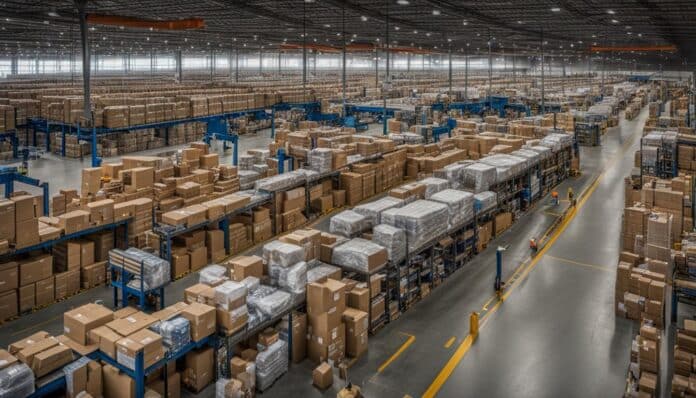Welcome to the world of reverse logistics in Singapore, where optimizing returns management is crucial for your business’s success. In today’s digital era, more and more businesses are shifting to an online presence, making returns management a key aspect of their operations. Implementing a streamlined reverse logistics process is essential for saving time, reducing costs, and improving customer satisfaction.
With the total retail returns projected to grow by 2.2% to $627.34 billion in 2023, having an effective reverse logistics management strategy is now more important than ever. Real-time tracking and reporting, clear return labels and instructions, efficient restocking procedures, transparent communication, and partnering with a trusted logistics company are all crucial components to optimize returns management.
Throughout this article, we will explore the importance of returns management in the digital commerce landscape, the key components of a streamlined returns management system, and the role of advanced technology in reverse logistics. We will also discuss the relationship between ESG management and reverse logistics, as well as the future of reverse logistics in building a sustainable business.
So, if you’re ready to enhance your supply chain efficiency, improve customer satisfaction, and stay ahead in the competitive market, let’s dive into the world of reverse logistics in Singapore.
The Importance of Returns Management in the Digital Commerce Landscape
Returns are an unavoidable part of the digital commerce landscape. Whether it’s a wrong size, a defect, or a change of mind, customers will inevitably request to return items they have purchased online. Efficient returns management is key to reducing costs and improving customer satisfaction in this ever-evolving digital world.
By implementing a streamlined reverse logistics process, businesses can save time and money while providing better overall satisfaction to customers. A well-managed returns system helps expedite the process, ensures timely refunds or exchanges, and minimizes any inconvenience experienced by customers.
Efficient returns management not only benefits customers but also reduces costs for businesses. By optimizing the reverse logistics process, companies can minimize transportation expenses, inventory holding costs, and operational inefficiencies. This, in turn, improves the bottom line and frees up resources to invest in other areas of the business.
Furthermore, customer satisfaction is closely tied to returns management. The ability to handle returns seamlessly and efficiently enhances the overall shopping experience and strengthens customer loyalty. Satisfied customers are more likely to make repeat purchases and recommend the brand to others, driving growth and success in the digital commerce landscape.
The Key Components of a Streamlined Returns Management System
A streamlined returns management system is crucial for optimizing supply chain efficiency and ensuring customer satisfaction. It involves several key components that address the challenges and complexities of the reverse logistics process.
1. Receiving Returned Products: Efficiently handling returned products is the first step in the returns management process. This involves accurately logging, inspecting, and categorizing the returned items to identify their condition and determine appropriate next steps.
2. Quality Inspections: Conducting thorough quality inspections is essential to assess the condition of returned products accurately. This step helps identify any defects, damages, or cosmetic issues that may impact their resale value or determine if they are eligible for repair or refurbishment.
3. Data-Driven Decisions: Making informed decisions based on data analysis is vital in returns management. By leveraging data about product returns, businesses can gather valuable insights that drive decision-making on restocking, repairing, or disposing of items. This data-driven approach enhances supply chain efficiency and minimizes financial losses.
4. Restocking Procedures: Implementing efficient restocking procedures is crucial for optimizing inventory management and order fulfillment. This includes promptly returning restockable items to inventory, ensuring accurate labeling and categorization, and updating product availability in real-time.
Supply chain efficiency is greatly influenced by effective returns management. By streamlining the reverse logistics process, businesses can reduce handling time and costs, minimize inventory disruptions, and improve overall supply chain performance.
6. Customer Satisfaction: Ultimately, all components of a streamlined returns management system aim to improve customer satisfaction. By providing hassle-free returns and timely resolutions, businesses can enhance trust, loyalty, and brand reputation among their customers.
A well-executed returns management system requires careful planning, integration of technologies, and alignment with overall business goals. By adopting a customer-centric approach and continuously evaluating and optimizing the process, businesses can maximize the value gained from returned products while ensuring a positive customer experience.
The Importance of Real-Time Tracking and Reporting in Returns Management
Real-time tracking and reporting play a crucial role in efficient returns management. By leveraging technologies like RFID and IoT, businesses in Singapore can gain valuable insights into their logistics operations and enhance the customer experience. The ability to track and monitor returns in real-time enables businesses to make data-driven decisions to streamline their logistics processes and improve supply chain efficiency.
Real-time tracking allows businesses to have immediate visibility into the status and location of returned items, reducing the risk of misplacement or lost returns. This level of visibility enhances customer trust and satisfaction as they can stay updated on the progress of their return.
Additionally, with real-time reporting, businesses can access accurate data on returns, enabling them to analyze trends and patterns. This data can be further utilized for data analytics and forecasting, helping businesses make informed decisions regarding returns management, inventory planning, and supply chain optimization.
The integration of real-time tracking and reporting into the returns management process also contributes to an agile logistics service. It allows businesses to proactively identify bottlenecks and inefficiencies, enabling them to take immediate corrective actions and provide a seamless returns experience for customers.
Furthermore, real-time tracking and reporting support effective collaboration between different stakeholders involved in the returns management process. This includes internal teams such as customer service, warehousing, and inventory management, as well as external partners such as logistics service providers. Timely access to relevant information ensures smooth coordination, minimizing delays and optimizing the overall returns process.
Overall, by embracing real-time tracking and reporting in returns management, businesses can enhance their logistics operations, improve the customer experience, and drive supply chain efficiency. With access to actionable data and insights, businesses can adapt, optimize, and continuously improve their returns management processes, ultimately leading to greater customer satisfaction and business success.
The Role of Clear Return Labels and Instructions in Returns Management
When it comes to returns management, providing clear return labels and instructions is essential for a smooth and efficient process. Clear return labels help ensure that packages are correctly identified and routed, minimizing delays and streamlining logistics services.
With clear return instructions, customers are empowered to easily navigate the returns process, resulting in a better overall customer experience. By providing step-by-step guidelines on how to return an item, including any specific packaging requirements or documentation needed, you can make the returns process hassle-free for your customers.
Clear return labels and instructions not only benefit your customers but also optimize your logistics operations. By reducing confusion and errors in return shipments, you can minimize delays and improve the efficiency of your reverse logistics processes.
Efficient returns management is crucial to maintaining customer satisfaction and building trust in your brand. By implementing clear return labels and instructions, you can enhance the customer experience, streamline your logistics services, and ultimately drive customer loyalty.
Streamlining Returns with Clear Instructions Example:
For example, let’s say a customer wants to return a product they purchased from your online store. By including a clear return label in the package, the customer can easily attach it to the return shipment. Additionally, providing instructions on how to initiate the return process online or through customer support ensures a seamless experience.
Once the return is received, your team can quickly identify the returned item, verify its condition, and process the refund or exchange accordingly. Clear return labels and instructions enable a more efficient returns management system, reducing the time and effort involved in handling returns.
In summary, clear return labels and instructions play a vital role in returns management. They improve the customer experience, optimize logistics operations, minimize delays, and streamline overall logistics services. By prioritizing clear and concise instructions, you can enhance the returns process and drive customer satisfaction.
Efficient Restocking Procedures for Effective Returns Management
Efficient restocking procedures play a critical role in effective returns management. When handling returned items, it is important to identify the best course of action – whether they should be resold, refurbished, or recycled. This requires strategic decision-making based on various factors such as the condition of the item, customer preferences, and market demands.
One way to optimize restocking decisions is through the use of AI algorithms. These advanced algorithms can analyze data and provide insights to help you make informed decisions about the most efficient and cost-effective restocking strategies.
By leveraging AI algorithms, you can identify which returned items are still in good condition and suitable for resale. This not only helps to reduce waste but also improves supply chain efficiency by minimizing unnecessary inventory holding. Additionally, it allows you to match customer demand with the available inventory, ensuring a seamless shopping experience and higher customer satisfaction.
Furthermore, efficient restocking procedures contribute to overall supply chain performance. By quickly and accurately restocking returned items, you can maintain optimal inventory levels and minimize stockouts. This helps to streamline operations, improve order fulfillment, and enhance the overall efficiency of your supply chain.
Implementing efficient restocking procedures is a key step towards achieving optimal returns management. By combining AI algorithms with strategic decision-making, you can maximize the value of returned items, improve supply chain efficiency, and ultimately enhance customer satisfaction.
The Importance of Transparent Communication in Returns Management
Transparent communication is a vital aspect of effective returns management. When it comes to handling returns, clear and timely updates are key to maintaining customer satisfaction and trust in your logistics operations. By providing transparent communication throughout the returns management process, you can ensure a positive customer experience and streamline operations.
When customers return a product, they rely on your company to keep them informed every step of the way. This includes providing updates on the status of their return, confirming receipt of the item, and notifying them of any necessary actions, such as refunds or replacements.
Transparent communication not only assures customers that their return is being processed, but it also helps manage their expectations. When customers have clear information about the returns process, they are more likely to feel confident in your company’s ability to resolve their issue quickly and efficiently.
Furthermore, transparent communication fosters trust by demonstrating your commitment to excellent customer service. When customers feel they can rely on your company to communicate openly and honestly, they are more likely to trust your brand and become loyal customers in the future.
In addition to enhancing customer satisfaction and trust, transparent communication also benefits your logistics operations. By keeping customers informed, you can reduce incoming inquiries and minimize the need for customer service intervention, allowing your team to focus on other important tasks.
To implement transparent communication in your returns management process, it is recommended to utilize automated systems. These systems can send automated updates and notifications to customers, ensuring consistent and timely communication. You can also provide customers with access to an online portal where they can track the progress of their return in real-time.
To summarize, transparent communication plays a crucial role in returns management. By providing clear and timely updates throughout the process, you can reinforce trust, enhance customer satisfaction, and streamline your logistics operations, ultimately improving the overall customer experience.
The Value of Partnering with a Trusted Logistics Company in Returns Management
When it comes to returns management, having a trusted logistics partner can make all the difference. By partnering with a company specializing in end-to-end logistics services, you can streamline your logistics operations and ensure a seamless returns experience for your customers.
A trusted logistics partner understands the complexities of returns management and has the expertise to navigate through them effectively. They have a deep understanding of the reverse logistics process, including receiving returned products, conducting quality inspections, and making data-driven decisions on restocking or disposal.
By collaborating with a trusted partner, you can enhance supply chain efficiency and improve customer satisfaction. They can provide real-time tracking and reporting, allowing you to stay updated on the status of returns at every stage. This transparency not only gives you peace of mind but also enables you to make data-driven decisions to optimize your supply chain.
Partnering with a trusted logistics company also provides an extra layer of assurance, especially if your business operates in complex markets like Singapore. Their industry expertise and knowledge of local regulations ensure compliance and minimize any potential issues or delays.
Furthermore, a trusted logistics partner offers end-to-end logistics services, meaning they can handle all aspects of your logistics operations, from transportation and warehousing to final delivery. This comprehensive approach simplifies the returns management process and ensures a seamless flow from start to finish.
When it comes to returns management, customer satisfaction is key. Partnering with a trusted logistics company demonstrates your commitment to providing exceptional service and a hassle-free returns experience. By working together, you can optimize your returns management process, improve supply chain efficiency, and ultimately enhance customer satisfaction.
The Role of Reverse Logistics in the Supply Chain
Reverse logistics plays a critical role in ensuring the smooth functioning of the supply chain. It encompasses the processes involved in managing returns and handling post-sale activities, such as product repairs, refurbishments, and recycling. By effectively managing reverse logistics, businesses can optimize their logistics operations, minimize disruptions, and enhance overall supply chain efficiency.
Efficient reverse logistics management involves systematically tracking and processing returned products, identifying the appropriate disposition options, and making data-driven decisions to minimize costs and maximize value. This includes determining whether items should be restocked, repaired, or disposed of, while considering factors such as product condition, demand, and supply chain performance.
Implementing an efficient reverse logistics system not only improves supply chain efficiency but also contributes to customer satisfaction. By providing customers with a seamless and hassle-free returns experience, businesses can enhance their brand reputation and build trust with their customers. Meeting customers’ expectations for hassle-free returns is crucial to fostering long-term relationships and ensuring repeat business.
One important aspect of reverse logistics is managing the flow of returned products through the supply chain. This involves coordinating with various stakeholders, including suppliers, manufacturers, distributors, and retail partners, to ensure the timely and effective processing of returns. By streamlining this process, businesses can minimize the time and resources spent on returns management, reducing costs and improving overall supply chain efficiency.
Furthermore, reverse logistics plays a vital role in sustainability efforts and environmental stewardship. By implementing responsible disposal and recycling practices for returned products, businesses can minimize waste, reduce their carbon footprint, and contribute to a more sustainable future. This not only aligns with corporate social responsibility goals but also enhances brand value among environmentally conscious consumers.
In summary, reverse logistics is an integral part of the supply chain that ensures the efficient management of returns and post-sale activities. By optimizing reverse logistics processes, businesses can minimize disruptions, enhance supply chain efficiency, and improve customer satisfaction. Additionally, implementing sustainable practices in reverse logistics contributes to environmental stewardship and strengthens brand reputation.
The Impact of Advanced Technology on Reverse Logistics
Advanced technology has revolutionized the field of reverse logistics, bringing about significant improvements in efficiency, data visibility, and sustainability. By harnessing the power of advanced technology, businesses can optimize their reverse logistics processes and enhance customer satisfaction while reducing their environmental impact.
Data Visibility and Analytics
Advanced technology enables real-time data visibility throughout the reverse logistics journey. By utilizing data analytics tools, businesses can gain valuable insights and make data-driven decisions to improve their logistics and warehousing processes. This allows for better tracking, monitoring, and management of returned products, leading to enhanced supply chain efficiency.
Efficient Repair and Refurbishment
Through advanced technology, repair and refurbishment processes in reverse logistics have become more efficient and cost-effective. Automated systems, AI algorithms, and robotic technologies help expedite the identification, diagnosis, and repair of faulty products, reducing turnaround times and minimizing operational costs. This ensures that returned items are quickly restored to a sellable condition and returned to the market.
Recycling and E-Waste Management
One of the key challenges in reverse logistics is the management of e-waste generated by returned electronic products. Advanced technology solutions facilitate responsible recycling and e-waste management by automating the sorting and disposal processes. This ensures that hazardous materials are properly disposed of, reducing the environmental impact and promoting sustainability.
Overall, the integration of advanced technology in reverse logistics has a profound impact on the entire supply chain. It improves data visibility, enhances logistics and warehousing processes, enables efficient repair and refurbishment, and promotes responsible recycling and e-waste management. By embracing advanced technology, businesses can create more sustainable and customer-centric reverse logistics practices.
The Relationship Between ESG Management and Reverse Logistics
Efficient reverse logistics plays a significant role in ESG (Environmental, Social, and Governance) management. By implementing sustainable practices, businesses can reduce their environmental impact and optimize their supply chain, ultimately enhancing brand value and promoting long-term sustainability.
One of the key benefits of reverse logistics is the reduction of greenhouse gas emissions. Through efficient returns management, businesses can minimize the transportation and logistics activities associated with product returns, thus decreasing their carbon footprint. This aligns with ESG initiatives that prioritize environmental conservation and sustainability.
Moreover, reverse logistics promotes sustainable practices throughout the supply chain. By adopting strategies such as recycling, refurbishment, and responsible disposal of returned products, businesses can contribute to a circular economy and minimize waste. These practices not only support ESG management but also demonstrate a commitment to environmental stewardship.
In addition to reducing environmental impact, reverse logistics helps optimize the supply chain. By efficiently handling returns, businesses can recover value from returned products and minimize inventory write-offs. This enhances supply chain efficiency, lowers costs, and improves overall operational performance, all of which are crucial aspects of ESG management.
Furthermore, the relationship between reverse logistics and ESG management extends to brand value. As sustainability becomes increasingly important to consumers, businesses that prioritize efficient returns management and sustainable practices gain a competitive advantage. By demonstrating environmental responsibility and social consciousness, brands can enhance their reputation and appeal to environmentally conscious consumers.
Overall, reverse logistics plays a significant role in ESG management. It reduces environmental impact, promotes sustainable practices, optimizes the supply chain, and enhances brand value. By embracing reverse logistics as a critical component of their business operations, companies can meet the growing demands for ESG strategy initiatives while driving long-term sustainability in the marketplace.
The Future of Reverse Logistics and its Role in a Sustainable Business
Reverse logistics plays a crucial role in building a sustainable business. By focusing on efficiency and harnessing advanced technology, businesses can optimize their reverse logistics processes while contributing to environmental, social, and governance (ESG) management. This not only enhances brand value but also increases customer satisfaction and ensures long-term business sustainability.
In today’s fast-paced and digitalized world, implementing efficient reverse logistics is essential. It allows businesses to effectively manage product returns, repairs, refurbishments, and recycling processes, reducing waste and minimizing the environmental impact. By embracing reverse logistics practices, companies can align their operations with sustainability goals, demonstrating their commitment to responsible business practices and meeting the evolving demands of customers who prioritize sustainability.
Advanced technology plays a pivotal role in shaping the future of reverse logistics. By leveraging data analytics, Internet of Things (IoT) devices, and automation, businesses can gain real-time visibility into their logistics operations and make data-driven decisions. This enables them to streamline the entire reverse logistics process, improving efficiency, reducing costs, and optimizing supply chain performance. Furthermore, the integration of advanced technology in reverse logistics enhances the overall customer experience, ensuring transparent and timely communication throughout the entire process.
As consumers become more conscious of the environmental impact of their purchases, reverse logistics becomes a crucial differentiator in brand value. By prioritizing sustainability and implementing efficient reverse logistics practices, businesses can build a positive brand image, strengthen customer loyalty, and gain a competitive edge in the market. Additionally, by minimizing returns-related issues and ensuring prompt resolution, businesses can significantly enhance customer satisfaction, leading to higher customer retention rates and increased profitability.






















































